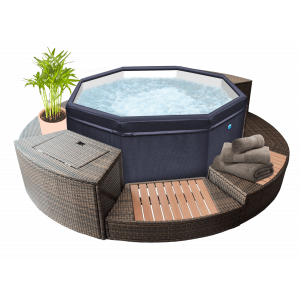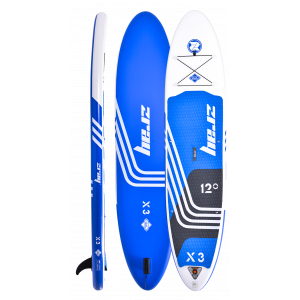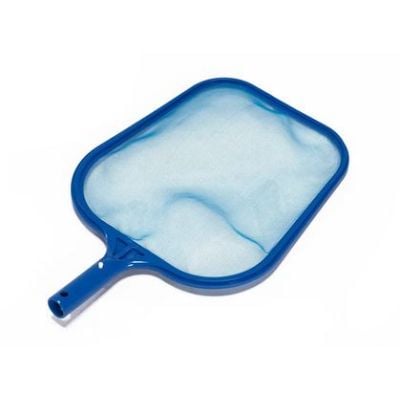Epuisette fond et surface pour votre piscine
4 products
The swimming pool landing net is an essential tool for maintaining your pool. It allows you to remove the largest waste on a daily basis and thus maintain clear water. The effects of this cleaning are instantaneous, but they are also crucial to avoid letting debris disintegrate and cause greater pollution. Here are all our tips for choosing and using a swimming pool landing net, distinguishing between the surface landing net and the bottom landing net.
What is the use of the swimming pool landing net?
There are several types of swimming pool landing nets, to allow you to cover your entire volume of water. In fact, debris does not all have the same density and, when it is not collected immediately, it becomes waterlogged and decays, which modifies this density. You must therefore have a swimming pool landing net which is designed to collect waste on the surface, between two waters and at the bottom. There you will find a jumble of leaves, twigs, pollen, flowers, insects, bird droppings and other debris carried by the wind.
Even if your pool is equipped with a fairly effective filtration system and you use a robot, you will still need a pool landing net to remove debris that has not yet been treated, while you want to swim. Furthermore, by removing the largest debris, you relieve your filtration system, as well as your skimmer-type collecting baskets.
If you don't use a robot, the pool landing net can replace it.
For a most reasonable investment, you have a practical and durable tool. You only need to provide a telescopic handle adapted to the size of your pool. You find models made of metal or plastic: the larger your handle, the more robust you should make it. Do not give in to a ridiculous price: generally the lifespan of this type of accessory is ridiculous, because you risk breaking it from the first uses.
Surface landing net or bottom landing net?
There are two types of accessories: the pool bottom landing net and the surface landing net.
The pool bottom landing net
The pool bottom landing net has a deep net which helps you capture, but also store in its bottom, debris floating between two waters and those deposited on the bottom. Its edge is flattened to fit the surface of the ground and not allow anything to pass through. Furthermore, thanks to the shape of the pocket net, the water is discharged through the center of the net, which makes it very efficient.
In addition to debris, the bottom landing net allows you to recover non-floating objects that you may have dropped inadvertently: jewelry, hair clips, sandals, etc.
The pool bottom net can even be versatile and can be used to collect surface debris.
The pool surface landing net
The surface landing net consists of a very shallow net. Its job is to collect surface deposits and debris. Due to its tense sieve, you must handle it delicately. In fact, if you move too quickly, a current is created which leads to the water spilling with the waste on the two side edges.
The pool surface landing net will also help you catch and bring together floating objects that you want to retrieve without getting into the water: balloons, fries, various toys, etc.
On the other hand, the surface landing net is not suitable for trapping debris between two waters or on the bottom.
The 2 in 1 swimming pool surface landing net Platypool
On this page you have the complete description of the Platypool surface landing net and we invite you to take an interest in it. It is indeed a tool whose clever design allows you to save record time when cleaning the surface of your pool, thanks to the very wide shape of the landing net and its deep net. Furthermore, its traction by a rope rather than the use of a telescopic handle prevents you from bending over and therefore putting excessive strain on your back which often makes you feel it.
The other advantage of the Platypool surface landing net in addition to adapting to all pool shapes is to be a 2 in 1 tool: in addition to filtering your water and remove impurities, the brushes located at each side end of the tool clean your water line at the same time.
Why the use of a fisherman's landing net is often not recommended
If you are a fisherman, perhaps you already have a landing net for your hobby and would also like to use it for cleaning your pond. This may be the case, but you must first check three criteria.
1. The mesh of a fishing landing net is often larger than that designed for the swimming pool. Small debris will pass through and it will only serve to capture large leaves, which is not enough to keep your water clean.
2. You must scrupulously clean your fishing net before each use. Whether it has been immersed in fresh water or salt water, it will be impregnated with micro-organisms which disrupt the balance of your water and risk causing significant pollution.
3. Finally, carefully observe the shape and composition of the edges of your fishing net, so as not to take the risk of damaging your liner, your hull or your swimming pool tiles.
How often should you use your pool landing net?
There is no typical recommended frequency for keeping your water pure, so the answer is: as often as necessary!
It all depends on the location of your pool, the season and the weather. The proximity of trees and fields increases the number of waste and the wind carries it at varying speeds. It is important to clean your water more often because if you allow debris to marinate, it will disintegrate and cause wider pollution of your water.
Advice for using the swimming pool landing net
Using the pool landing net is very simple. With the Platypool landing net, you grab the rope to tow the tool and go around your pool. With a classic model, bottom or surface, you grab the handle with both hands and go fishing for the largest debris. Empty your net before making new passages by drifting your net, while you come and go from the edge of your pool. Make broad, slow movements. Above all, do not create a current by going too quickly, as the debris could move aside in the path of the landing net. You can get your children involved from around the age of 7 because they often find it fun.
Respect these three rules:
1. Do not proceed too quickly, because the waste will escape you and you will have to multiply the number of passes;
2. If debris is stuck to the walls or on the floor, do not use force, because you will scratch your liner, your shell or your tiles (unless your tool is equipped with a scraper designed for this purpose); it is preferable to first use a brush to loosen it, before catching it with the landing net;
3. Never use a landing net with a broken structure, as any sharp edge will irreparably damage the surface of your pond.
See Also
Cookies
With cookies, enjoy a better experience on our site. We use them for statistical, analysis or advertising purposes.
Learn moreAnalytical cookies| ||1422
Ces cookies nous permettent de faire de l'analyse statistique et améliorer notre site. Pour les accepter, veuillez cocher la case.
Cookies marketing
These cookies allow us to offer you an ever more optimized experience with the help of our partners.
Essential cookies
These cookies are necessary for the operation of the site for your purchasing experience and your customer account. You cannot refuse them.









